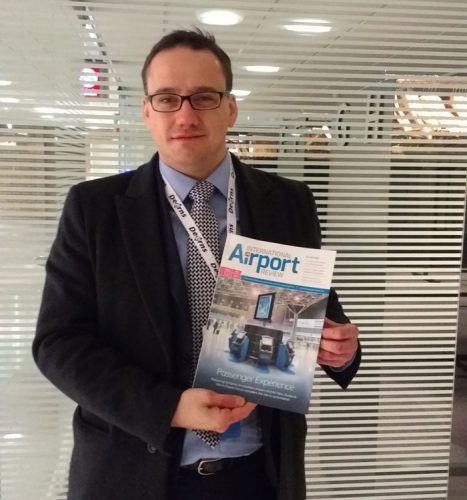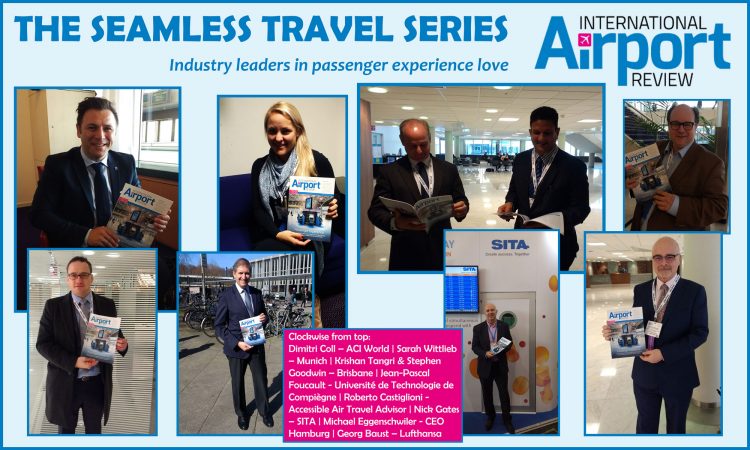The changing relationship between airports and airlines | Seamless Travel Series
- Like
- Digg
- Del
- Tumblr
- VKontakte
- Buffer
- Love This
- Odnoklassniki
- Meneame
- Blogger
- Amazon
- Yahoo Mail
- Gmail
- AOL
- Newsvine
- HackerNews
- Evernote
- MySpace
- Mail.ru
- Viadeo
- Line
- Comments
- Yummly
- SMS
- Viber
- Telegram
- Subscribe
- Skype
- Facebook Messenger
- Kakao
- LiveJournal
- Yammer
- Edgar
- Fintel
- Mix
- Instapaper
- Copy Link
Posted: 17 May 2017 | Georg Baust | Senior Consultant | Lufthansa Consulting, Sarah Wills | Editorial Assistant | No comments yet
Traditionally enjoying a troublesome relationship, airports and airlines are beginning to realise that they share the same objective: ensuring customer satisfaction.


International Airport Review’s Roy Manuell, caught up with Georg Baust, Senior Consultant at Lufthansa Consulting during Passenger Terminal Expo to glean his stance on technology, passenger experience and cooperation between airports and airlines.
RM: Your speech at Passenger Terminal Expo includes aspects of the ‘door-to-door’ experience, why do you think this is becoming such an issue within the industry?
GB: At the moment the industry is advancing to a place where constituents see themselves as not just an airport, not just an airline, but more as a mobility or travel access system. This is a focus of my speech because of the concern of just how to master digital transformation, why it is so important to be able to do so right from the beginning, and then be able to innovate and create new business models on top of that. A mobility ecosystem is definitely one, if not the, topic that we’re going to be experiencing.
At the moment we have very complex legacy systems, which need to be simplified, especially from an airline perspective.. Equally you need to consider the customer experience element, essentially simplifying life for the customers when they travel. If you achieve both of these aspects, and have both working correctly, then you can build on top of it, and then you can build on top of that, and ultimately create the travel ecosystem that you aspire to.
If the customer wishes to travel he doesn’t essentially care whether he travels with an airline or with a railway company, whoever it may be, he just wants to reach his destination preferably fast and convenient. And there are many different possible elements in any one passenger’s mobility chain for each journey they make. For example, when travelling here I car-shared to get to the airport, then I took my plane, and then a taxi, so there were three components in my mobility chain. Now, if a journey such as this could be achieved through an ecosystem, for example, an airline loyalty program that covers all of these components, then the airline would have the means and possibility of keeping passengers travelling entirely through their system each time they want to travel.
RM: Do you think this will become a viable proposition for airports, airlines, brands if you like, in the aviation industry? Do you think, for instance, Lufthansa will physically be able to provide this kind of door-to-door transition?
GB: I don’t think that they have to own the whole thing per se; they only need to be able to provide the access. Take Airbnb for instance, they don’t own a single hotel, yet they’re the largest provider of access to beds so to say, or take Uber, they don’t own a single taxi yet they provide transportation within a city from A to B. Keeping those examples in mind it is clear to see that through partnering as well as owning such companies, you could be able to provide a platform that delivers this type of door-to-door travel. That is the way in which I think airlines or each and every travel element in such a chain could own the whole chain.
RM: So if it were to happen you believe it would be the airlines driving all of this?
GB: I think, the airports also have quite a big stake. For example they can provide other things such as duty free shops or car sharing facilities. The level an airline or airport can offer can be greatly heightened if they are viewed by passengers as much more than just a means of transportation.
RM: Based on this, it is my understanding that airlines want to move their passengers as quickly as possible and for that travel to be as seamless as possible. So in that sense perhaps it is naturally upon the airlines to create this door-to-door seamless experience?
GB: I know what you mean, but I do think that the airports need to understand their role in this ecosystem too. While there are many, for example, business passengers, who wish to travel as quickly and efficiently through an airport as possible, I believe that there are also a lot of people who love to travel, who enjoy going into duty free shops, and embracing the whole experience of being at an airport. Not every passenger wants to get quickly from A to B, and, for myself included, the travel across an airport is part of the game and I think that airports should embrace that.
RM: So the onus is on personalisation there, for airlines, but perhaps more especially for the airports?
GB: Absolutely, and I do believe that nowadays you see instances where airports and airlines are perhaps not the best of friends, especially in terms of data sharing and similar matters. But I do think that sharing data would enable, for example, an airport to better understand how an airline customer behaves and what they expect from the service, and vice versa. Surely the more data you have the greater potential number of details there are to personalise.
Within Germany I know that there are issues with data, particularly in terms of privacy. I think a key element in gaining information from the customer is showing them how it will be used, how it could be personalised to their benefit. I believe that if the benefit was entirely seamless door-to-door travel then this would be a great incentive.
RM: So how do you get airports and airlines into the same room?
GB: I do think that airlines and airports understand that they need each other, without airlines an airport would be quite obsolete, and on the other hand if you didn’t have an airport then the airlines would have nowhere to land. The point is that there are more needs directed in the same direction than apart.
RM: Like Lufthansa and Frankfurt, KLM and Schipol etc…
GB: I’d never profess to be an expert on how their relationships function, so I’m not going to comment directly on those examples, but I do think that successful working relationships are evident all around us. In Frankfurt for example, you can see Lufthansa everywhere, and Lufthansa has a strong say on how they want to be presented.
It also works for Fraport as, if their passengers can pass quickly through security, they have time to benefit from the services and facilities in the airport, such as attractive duty free shopping. They have a first class terminal for Lufthansa, for example, which helps to tailor the travel experience to the differing needs and expectations of perhaps the business passenger, as opposed to let’s say passengers travelling on vacation, and I think Fraport and Lufthansa have understood that.
RM: A good model that perhaps the rest of the industry could follow?
GB:I do think that cooperation is much more important than hostility and disagreement over issues such as payment for projects. I remember back in 2007 when I was working on a project, there was much discussion about who was going to pay for self-service check-in confirmation systems, whether it was the airline or the airport. I think, this sort of question has, and most likely will always, be there, but it is possible to find solutions that suit all parties. In the end I think it is more important to consider what the customer wants; whether it’s the business customer who purely wants to get from A to B as quickly as possible, or it’s the customer who enjoys duty free shopping and getting a particular product not available anywhere else. If the parties work together while considering the customer they will surely find a way where everybody wins.
RM: What are you most excited about technologically at the moment, what’s going to define 2017?
Will there be one blockchain for every case and company?
GB: One innovation, regarding customer loyalty programs and other use cases, which, for me, is quite the technology, is blockchain. Naturally there are still questions to be answered; Will there be one blockchain for every case and company? Will there be one blockchain for all loyalty programs, etc.? But, I do think that this could be a technology that enables many use cases to go the next level. Blockchain enables that in a way that wasn’t possible before and I do think this is one of the ones to watch. Although I’m not sure if this will be ready for 2017, it is coming and I do think that it’s one of technologies where you will see, in 10 years’ time, just how large an impact it has made.
RM: So conversely what’s the biggest challenge we face in 2017? Is it security?
GB: I think essentially there are the same challenges that we have always faced; security, collaboration between various parties for example. I think one of the key challenges we face is providing the passengers with exactly what they expect and pay for, to know at which level to help each passenger, and to see their journey through their eyes, because this is something that a lot of companies are not doing so well in my opinion.
Of course I would say that security continues to be a hot topic, though I don’t see it as a standout challenge of 2017. I think we’re at a stage where a lot of people are kind of scared to a level that’s not justified. We have to trust the good systems that we have, but we also need to look into easing security levels at some point. There will always be certain aspects within the aviation industry where you’ll never change anything in terms of optimising, saving costs and so on, and security is definitely one of these. But you can still find ways to be very secure while still making the process as easy and straight forward as possible for the passengers.
International Airport Review would like to thank Georg for his insight and invites you to have a look at The Seamless Travel Series so far…


Elevating experience at Hamburg – Hamburg CEO Michael Eggenschwiler
Small changes, big differences for PRMs – Roberto Castiglioni, Accessible Air Travel Advisor
Using data to improve operational efficiency – Nick Gates, Product Portfolio Director at SITA UK
Related topics
Airside operations, Economy, Passenger experience and seamless travel, Terminal operations


















